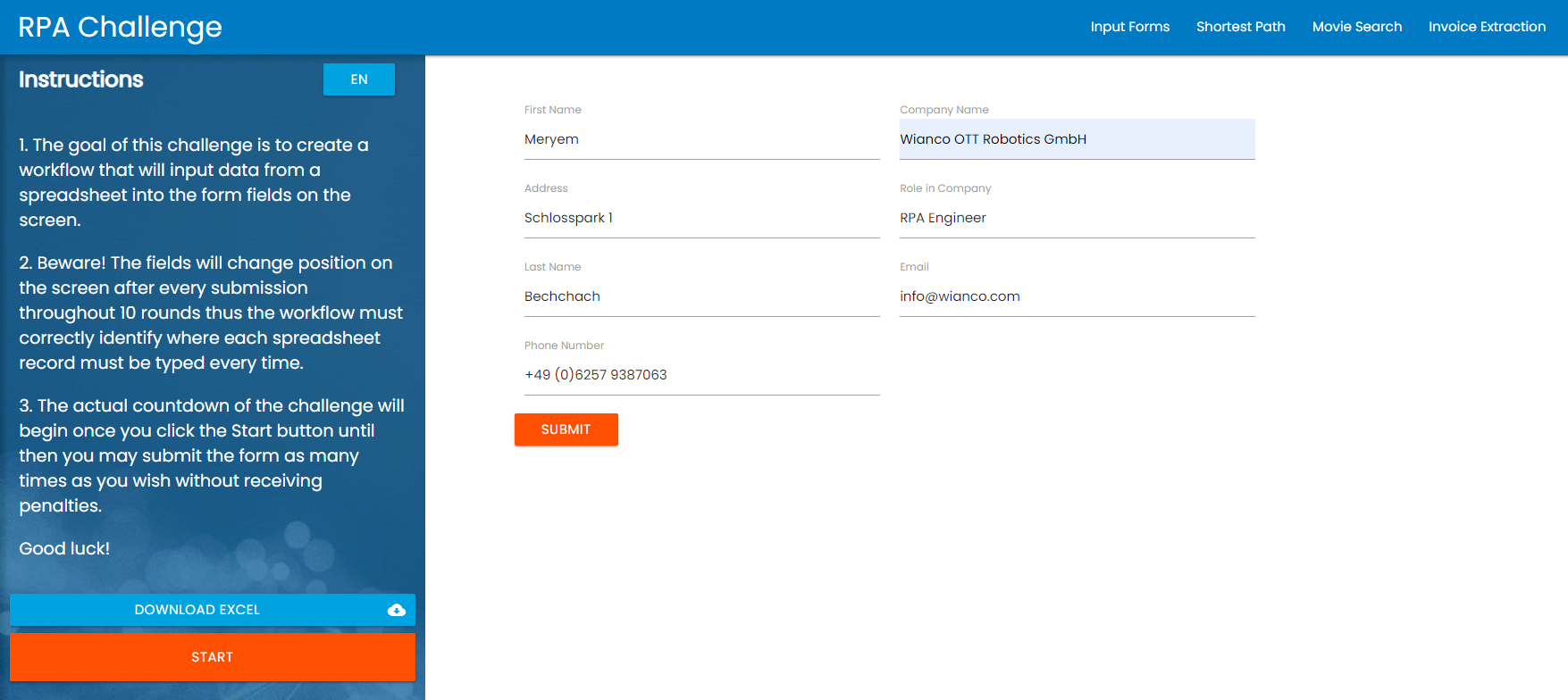RPA Challenge - EMMA masters the challenge through Cognitive AI

Google challenges RPA developers and RPA solutions
Technological possibilities of Robotic Process Automation (RPA) are increasingly being expanded to include the capabilities of Artificial Intelligence (AI), Machine Learning (ML) and Natural Language Processing (NLP). Reason enough to start an RPA Challenge to challenge the best RPA solutions.
You can also start directly on the website www.rpachallenge.com. The aim of the RPA Challenge is to solve various problems on the website. Currently there are the following 4 different tasks:
- 1.) The dynamic input form
- 2.) Shortest path
- 3.) The film search
- 4.) The invoice statement
RPA Challenge 1: The dynamic input form
The aim of this challenge is to create an automation system that enables employees to enter data from a downloaded Excel spreadsheet into the form fields on the screen. The specialty is that changes the position of the fields on the screen after each form submission during the 10 rounds - both in the order of the data to be transmitted and in the arrangement and position of the associated fields. Therefore, the robot has to correctly identify the right places every time in order to enter each record in the appropriate field.
The actual countdown of the RPA Challenge begins as soon as the robot has clicked on the start button. Until then, the RPA developers can submit the form as often as they want without receiving any penalties.
RPA Challenge 2: Shortest Path
The aim of the second RPA task is to create a so-called "Attended Bot" (a supervised robot) that works together with the user - the so-called "Human-in-the-Loop".
In this RPA challenge, the user has to assign a demand (marked as a RED point) to the closest offer (marked as a GREEN point), whereby two tables are filled with data.
The robot has to fill in the required data within the form using the data in the tables generated in step 2. The form returns a contract value to the robot, which must be pasted back into the Contract text box. This must be repeated until no more red dots are displayed on the map.
RPA Challenge 3: The Movie Search
The goal of the third RPA challenge is to create an automation that checks which film review is positive or negative.
To do this, the robot adds 3 films to a list to start the challenge. The robot can either search for the movies or get a list of 3 popular movies.
The robot has to click on each film in the film list to display the film reviews. He should also check every evaluation to see whether it is positive or negative. After the robot has checked all ratings, it should click the send button to display the number of points achieved.
RPA Challenge 4: The Invoice Statement
Last but not least, the goal of the fourth RPA challenge is to configure a robot that reads every table line on the page and downloads the corresponding invoices via the respective download button.
The robot should extract the invoice number, the invoice date, the company name and the total amount from the invoices.
Then the robot has to create a CSV file with the data extracted from each invoice, as well as the ID and the due date from the table and then upload the CSV file - attention - but only for the invoices for which the due date is today or has already expired.
The actual countdown of the RPA Challenge begins as soon as the robot clicks the Start button and ends as soon as the CSV file has been uploaded. Until then, RPA developers and robots are allowed to play around with the table on the right without incurring penalties.
At the bottom of the 4th RPA Challenge page is a sample CSV file that shows the required format for the final result and two sample calculations. The formats of the invoices correspond exactly to these patterns and do not change in the course of the RPA Challenge. The RPA Challenge expects that the uploaded CSV has exactly the same format as the sample CSV, including the formatting of the cells, and that the rows are in the same order as they are displayed in the table. Any difference will result in a failure for the RPA Challenge.
All further details and the RPA Challenge itself can be found on www.rpachallenge.com
The WIANCO OTT Robotics Team wishes all participants a lot of success and, above all, fun solving the RPA challenges.
Text author: Meryem Bechchach





